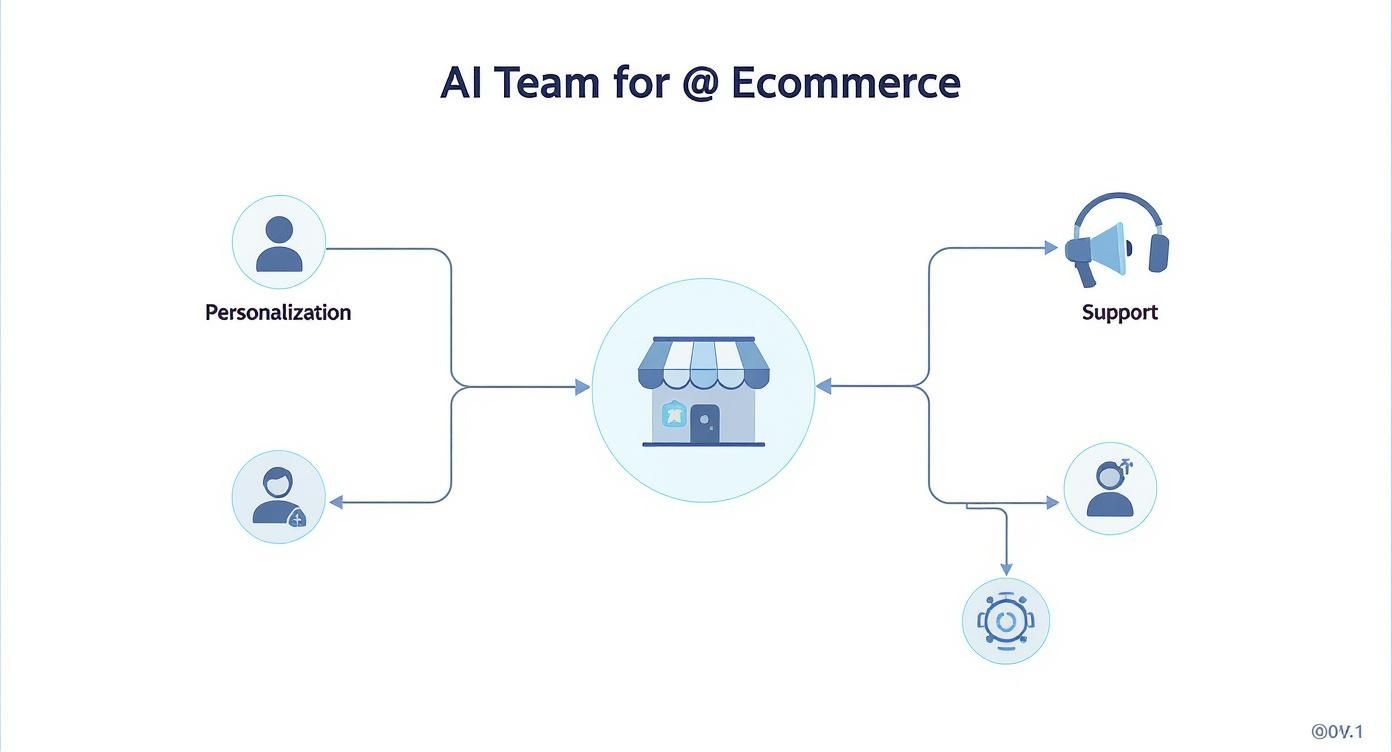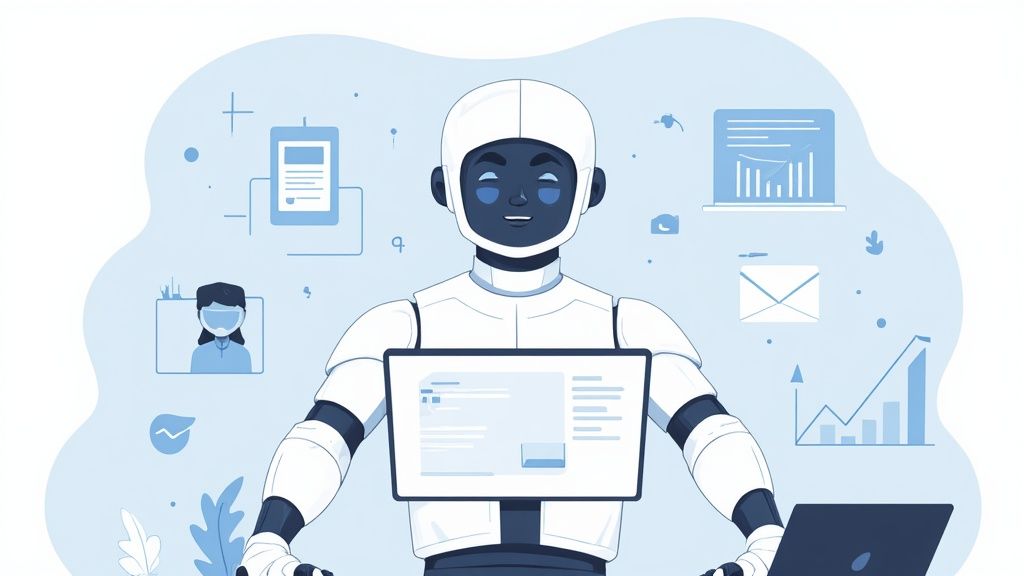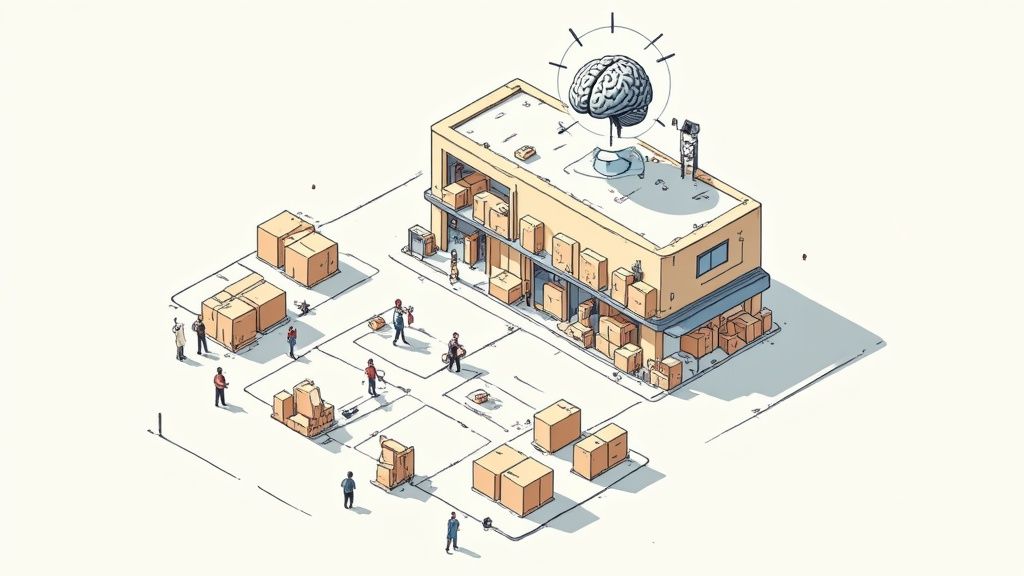Forget the idea of finding one single, magical AI tool that does everything. The best AI setups for e-commerce are more like a strategic toolkit, where each tool tackles a different, specific business need. We’re talking about AI for hyper-personalization (like smart recommendation engines), marketing automation (to supercharge ads and emails), customer support (think tireless chatbots), and even backend operations (like predicting inventory needs).
Building a killer e-commerce brand today means assembling a specialized "AI team," with each solution solving a particular problem.
The AI Revolution Powering Ecommerce Success
The whole conversation around AI in e-commerce has completely changed. What felt like a futuristic gimmick just a few years ago is now a core part of any serious digital strategy. Smart store owners aren't looking for one "best" tool anymore; they're thinking like a general manager building a team. Each AI solution is a specialist, hired for a specific job, and they all work together to create a seamless, smart, and profitable experience for the customer—from their very first click to the moment their package arrives.
This isn't just hype; it's backed by some serious numbers. The global AI-powered e-commerce market is sitting at around $8.65 billion in 2025. And it's not slowing down. Analysts expect it to grow at a compound annual rate of 14.6%, rocketing to $22.60 billion by 2032. That kind of explosive growth tells you everything you need to know about how critical AI has become for driving real results. You can dig into more numbers in this ecommerce AI statistics report.
Your AI Team Roster
Picture your e-commerce store as the main headquarters, supported by a dedicated crew of AI specialists. Each one is in charge of a vital function, making sure the entire operation hums along without a hitch.
This map gives you a great visual of how these different AI categories fit together to form a solid support system for your online store.

As you can see, a winning AI strategy isn’t about a single tool. It’s about weaving together personalization, marketing, and support into one cohesive system.
To give you a better feel for the different players you can recruit, here's a quick rundown of the main AI tool categories and what they do.
Key AI Tool Categories for Ecommerce at a Glance
| AI Tool Category | Primary Business Goal | Example Use Case |
|---|---|---|
| Personalization Engines | Increase conversions and AOV | Showing "You Might Also Like" product carousels based on browsing history. |
| Marketing & Content AI | Drive targeted traffic and sales | Automatically generating dozens of ad copy variations for different audience segments. |
| Customer Support Bots | Improve customer satisfaction and reduce support costs | A chatbot instantly answering "Where is my order?" 24/7, without human intervention. |
| Operations & Logistics AI | Boost efficiency and reduce overhead | Forecasting demand for a specific product to prevent stockouts during a holiday sale. |
Each of these roles is essential. Let’s break down the core players on your AI team a bit more.
-
The Personalization Expert: This is your AI-powered personal shopper. It dives deep into customer behavior—clicks, views, past purchases—to customize the experience for every single visitor. It’s the brains behind those dynamic product recommendations and tailored search results that make each person feel like the store was built just for them.
-
The Marketing Strategist: Think of this as your automated campaign manager. It fine-tunes your ad spend, whips up irresistible email subject lines, segments your audience for hyper-targeted promotions, and even helps write persuasive product descriptions. Its job is to make sure your message always lands perfectly.
-
The Support Agent: Modern AI chatbots are your front-line support heroes, working 24/7. They handle all the common questions—like order tracking and return policies—which frees up your human agents to tackle the trickier issues. The result? Happier customers who get instant answers.
When you bring these tools together, you create a powerful flywheel. Better personalization drives more effective marketing, which leads to more sales. Then, excellent AI-powered support builds loyalty, feeding more data back into the personalization engine to kick the whole cycle off again, but even smarter this time.
This guide will walk you through each of these specialized roles. We’ll cover how they work, the benefits they bring to the table, and how to pick the right players for your unique team. We've got everything from making every shopper's journey feel personal to streamlining your backend for peak efficiency.
Creating Hyper-Personalized Shopping Experiences with AI
Imagine walking into your favorite local shop, where the owner knows you by name, remembers what you like, and points you straight to the new arrivals they know you'll love. That's the exact feeling AI personalization tools are creating online, but at a massive scale. They act as a dedicated personal shopper for every single visitor, turning a generic e-commerce site into a curated, one-of-a-kind boutique.
These sophisticated systems are the engine behind a modern shopping experience. They work silently in the background, piecing together a puzzle from thousands of data points in real time. Every click, every search, every item you add to your cart—it all becomes a clue that helps the AI understand your unique tastes and what you're looking for right now.
Moving Beyond Basic Recommendations
We’ve all seen the simple "customers who bought this also bought" widgets. Honestly? That's old news. Today's AI-powered personalization runs circles around that, creating a fluid and responsive shopping journey that feels almost intuitive. Instead of just showing related items, these tools can dynamically reorder entire product categories, highlight specific promotions, and even adjust search results to match what they predict you really want to find.
Getting this right is what separates a good store from a truly great one. The impact on the bottom line is undeniable—AI-powered recommendation engines are now responsible for roughly 31% of e-commerce revenue globally. They don't just sell products; they solve the nagging problem of discovery, making it ridiculously easy for customers to find items they'll actually love.
By making every shopper feel seen and understood, AI personalization builds a powerful emotional connection. It's the digital equivalent of that favorite shop owner who gets you. It’s how you build lasting loyalty.
The numbers really drive this home. AI is now a core part of business success, with 86% of brands reporting huge improvements in their ability to tailor customer experiences. This leads to very real results. For instance, real-time product suggestions can boost conversion rates by an estimated 29%, while smart AI segmentation allows 74% of marketers to target audiences with far greater precision. If you want to dig deeper, check out these key AI in marketing statistics.
The Core Capabilities of Personalization AI
To really get why these tools are so valuable, you need to understand what they're actually doing behind the scenes. They're some of the best AI tools for e-commerce because they directly shape a customer's path from browsing to buying.
- Predictive Product Recommendations: The AI analyzes a user's behavior to guess what they'll want to buy next, then presents those options at just the right moment—on the homepage, a product page, or right at checkout.
- Hyper-Personalized Search Results: This is way more than just matching keywords. An AI-driven search understands intent. So, a search for "summer dress" might show very different results for someone who’s been browsing floral patterns versus another person who was just looking at formal wear.
- Dynamic Content and Offers: The AI can customize the entire website experience on the fly. It can change homepage banners, promotional pop-ups, and even the text on "buy now" buttons to resonate with an individual's browsing history or demographic.
- Visually Tailored Experiences: It's not just about what you show, but how you show it. If a customer shows interest in a certain color, the AI can make sure that product images featuring that color are front and center across the site. Great visuals are non-negotiable, which is why a top-tier AI product photo generator is the perfect partner for any personalization strategy.
By weaving these features into your store, you can dramatically increase your average order value (AOV) and customer lifetime value (LTV). Each interaction becomes a chance to strengthen the relationship, turning one-time buyers into loyal fans who feel a genuine connection to your brand. That's a powerful competitive edge that's tough for slower-moving competitors to beat.
Driving Growth with AI-Powered Marketing Automation

Think of AI marketing tools as your smartest, most tireless new hire. This specialist works 24/7, never asks for a coffee break, and is obsessed with one thing: squeezing every last drop of ROI from your campaigns. It’s the secret weapon that lets smaller brands go toe-to-toe with industry giants, making data-backed moves at a speed no human team could ever hope to match.
Instead of manually guessing which ad to run or what email subject line will get the most opens, AI takes over the grunt work. It chews through massive datasets in real-time, spotting patterns and opportunities that are completely invisible to the human eye. This frees up your team to think about the big picture and get creative, rather than getting stuck in the weeds of repetitive tasks.
Mastering Digital Advertising with AI
Nowhere is the impact of AI felt more than in digital advertising. Platforms like Google Ads and Facebook Ads have become incredibly complicated mazes. Finding a positive return on your ad spend requires constant babysitting and tweaking. AI-powered tools turn this whole process on its head, shifting ad management from a guessing game to a science.
These systems become your autonomous campaign managers, handling the mission-critical stuff without you lifting a finger:
- Automated Bid Management: The AI is always adjusting your ad bids based on what’s working right now. This makes sure you never overpay for a click and your budget flows directly to the most profitable keywords and audiences.
- Audience Targeting and Segmentation: By analyzing customer data, AI builds incredibly specific audience segments. It can pinpoint and target users who are practically screaming "I'm ready to buy," which dramatically improves your ad relevance and slashes acquisition costs.
- Creative Optimization: Some of the best tools can even A/B test ad copy, headlines, and images on a massive scale. They'll automatically push the winning combinations that get the most clicks and sales.
When you let AI handle the tiny details of your ad campaigns, you stop reacting and start predicting. The system doesn’t just look at past performance; it anticipates future trends and tunes your strategy accordingly, keeping you one step ahead of the competition.
Scaling Content Creation and Communication
Beyond ads, AI is a total game-changer for writing content and talking to customers. Imagine manually writing unique product descriptions for thousands of items or crafting personalized emails for a dozen different customer segments. It's a colossal time-sink. AI marketing tools can knock out these tasks in a tiny fraction of the time, all while keeping your brand voice consistent everywhere.
Just think about how AI can automate your communication. To see how you can supercharge your marketing automation and drive more sales, you can learn more about using chatbots for marketing to engage customers right when they land on your site. These systems handle the initial chats, freeing up your team while collecting valuable feedback.
Here’s how this tech gives your content strategy a serious upgrade:
- Persuasive Copywriting: AI can generate a huge list of compelling email subject lines, social media posts, or even first drafts for blog posts. It gives your marketing team a fantastic jumping-off point for their creative work.
- SEO and Content Intelligence: AI-driven SEO tools can uncover keyword opportunities you'd never find on your own. They analyze what's already ranking at the top and give you a clear roadmap for improving your own content, even predicting which topics your audience will love next.
- At-Scale Product Descriptions: If you have a huge catalog, writing unique and interesting copy is a nightmare. A product description generator, like the AI writer from ProdShot, can instantly create engaging descriptions that fit your brand, boosting both your SEO and your conversion rates.
At the end of the day, AI-powered marketing automation is all about doing more with less. It's about reaching more of the right people with more relevant messages, all while saving you hundreds of hours of manual work. This is how you scale your growth intelligently, ensuring every single dollar you spend on marketing is working as hard as it possibly can for your business.
Transforming Customer Support with Intelligent AI

In e-commerce, customer support isn't just a department anymore—it’s a massive competitive advantage. Today's AI chatbots are a world away from the clunky, robotic responders of the past. Think of them as your smartest, most reliable support agents who are always on, turning your customer service from a cost center into a real growth engine.
These tools offer instant, 24/7 support, meaning no customer question ever goes unanswered, no matter the time zone. That kind of immediate help is huge for building trust and turning a moment of frustration into a positive experience with your brand.
From Simple Answers to Smart Solutions
The best AI tools for e-commerce have moved way beyond basic FAQ bots. They now tackle a whole range of complex tasks that once needed a human to step in, smoothing out the entire support journey.
This has a real, measurable impact on the bottom line. Retailers using AI chatbots see a conversion rate of 12.3%, a huge jump from the 3.1% rate for shoppers who don’t interact with an AI. Even better, returning customers who chat with an AI tend to spend about 25% more. These numbers show just how powerful these tools are for keeping customers happy and increasing their lifetime value.
Here are just a few things these advanced systems can handle on their own:
- Instant Order Tracking: Answering the classic "Where's my order?" question without ever needing a human.
- Automated Return Processing: Walking customers through the returns process, generating labels, and updating order statuses automatically.
- Detailed Product Inquiries: Digging into your product catalog to answer specific questions about materials, sizing, or stock levels.
This level of automation doesn't just solve problems faster. It frees up your human support team to focus on the tricky, high-value issues that actually need a personal touch.
An intelligent AI chatbot is the ultimate gatekeeper. It fields all incoming requests, solves most of them on its own, and seamlessly passes the rest to the right human agent—with the full chat history, so the customer never has to repeat themselves.
Turning Support into a Sales Opportunity
A great AI support tool doesn't just fix problems; it actively creates sales. By looking at a customer's question and browsing history, these bots can flip from a support agent into a personal shopper, all in the same chat.
For example, after helping a customer find the right shoe size, the AI could suggest a matching belt or a shoe care kit. This kind of smart upselling and cross-selling turns every support chat into a potential revenue stream. You can take this even further by using tools that bring conversational intelligence in video to your product demos.
Uncovering Actionable Business Insights
Maybe the most underrated perk of AI in customer support is its ability to listen at scale. Every single support conversation is a goldmine of data about what your customers need, what frustrates them, and what they really want.
An AI can sift through thousands of chat logs to spot recurring themes. Are customers constantly asking about your shipping policy to a certain country? Are lots of people confused about a feature on a new product? This feedback loop gives you priceless insights to improve your products, your website, and your entire strategy, making sure you’re always in sync with your customers.
2. Optimizing Your Backend with AI-Driven Operations
A killer customer experience is only half the battle. The other half is won behind the scenes, with a rock-solid operational foundation that just works. This is where AI plays one of its most important—if less glamorous—roles. Think of it as your master logistics coordinator, a silent partner making sure every order is fulfilled perfectly and on time.
While frontend tools get all the credit for bringing in sales, the best AI tools for ecommerce humming away on your backend are what make sustainable growth possible. They chew through the complex, data-heavy work of inventory, fulfillment, and security, turning potential operational headaches into a real competitive edge.
Predictive Inventory Management
Let's be honest, managing stock levels is one of the biggest headaches for any online retailer. Overstocking ties up your cash in products nobody's buying. But stockouts? They lead to lost sales and ticked-off customers who might never come back. AI-powered inventory management swaps out the guesswork for actual data science.
These systems analyze a ton of different data points to predict demand with scary-good accuracy:
- Past Sales Data: Spotting the usual seasonal peaks and dips for specific products.
- Current Market Trends: Keeping an eye on social media and search data to see what's about to pop.
- Marketing Plans: Knowing that an upcoming promo is going to cause a spike in demand.
- Outside Factors: Even factoring in things like holidays or local events that might change how people shop.
By predicting what customers will want next, AI makes sure you have the right stuff on your shelves at the right time. No more costly overstocking, and no more disappointing your customers by running out of their favorite items.
Streamlining Warehouse and Fulfillment Logistics
The moment an order is placed, the clock starts ticking. You've got to get that package to the customer's door as fast and as cheaply as you can. AI brings a whole new level of smarts to this race, optimizing every single step from the warehouse floor to the final delivery.
For instance, AI can map out the most efficient picking routes for your warehouse team, shaving precious minutes off the time it takes to gather items for an order. It can also analyze shipping carrier data in real-time to pick the fastest, most cost-effective option for each package, saving you both time and money.
Operational efficiency isn't just about saving a few bucks; it's a core part of building customer loyalty. When a package shows up earlier than expected, it tells the customer they can trust your brand. That's how you get them to shop with you again and again.
Proactive Fraud Detection and Security
In the world of online retail, security is everything. A single fraudulent transaction is bad enough, but a pattern of them can be devastating. Old-school fraud prevention systems often rely on clunky, rule-based filters that end up flagging legitimate purchases by mistake. The result? Lost sales and angry customers.
AI-powered fraud detection is way more sophisticated. It crunches thousands of data points for every single transaction in real-time, looking for the tiny, subtle patterns that signal fraud. This includes things like:
- How many transactions are happening and for how much.
- Weird inconsistencies in geographic location.
- Device information and how the user is behaving on your site.
This approach lets AI pinpoint and block genuinely fraudulent orders with incredible accuracy, while legitimate customers sail right through checkout. It's a dynamic kind of security that minimizes chargebacks, protects your revenue, and creates a trustworthy shopping environment for everyone.
How to Choose the Right AI Tools for Your Store

Jumping into the world of AI can feel like trying to drink from a firehose. There are thousands of tools out there, all promising incredible results. The secret isn't to adopt everything at once, but to start small and be strategic. The best AI tools are the ones that solve your biggest headaches first, giving you a clear win before you expand your toolkit.
Think about it this way: instead of trying to completely rebuild your business overnight, find your single biggest bottleneck. Is your customer support team buried in tickets? Are abandoned carts killing your conversion rates? Pinpointing that one major pain point gives you a clear target, making the choice for your first tool a whole lot easier.
Starting with a Single Solution
The smartest way to bring AI into your business is one step at a time. By starting with one tool designed to solve one specific problem, you're essentially running a controlled experiment. This lets you measure its impact accurately and build a real business case for future investments based on hard data, not just hype.
The goal is to create a positive feedback loop. You spot a problem, bring in a targeted AI solution, measure the positive ROI, and then use that success to fund your next move. This methodical approach takes the risk and overwhelm out of the equation.
This strategy ensures that every new tool you add brings real, measurable value straight to your bottom line.
Key Evaluation Criteria for AI Tools
When you start comparing different AI solutions, it’s easy to get distracted by flashy features. But you need to look at the fundamentals that will actually make a difference long-term. Not every tool is created equal, and what works for a retail giant might be total overkill for your growing store. A great tool should feel like a natural part of your workflow, not some clunky add-on you have to fight with.
Here are the must-haves to look for before you commit:
- Seamless Integration: How easily does this tool plug into your existing e-commerce platform? A tool with a native Shopify or BigCommerce app is going to be infinitely simpler to get running than something that needs a ton of custom code.
- Ease of Use: You shouldn't need a Ph.D. in data science to use it. Look for tools with clean dashboards, clear instructions, and helpful support. You want to be able to get up and running fast.
- Scalability: Can this tool grow with you? It needs to handle your current traffic and sales volume, but it also needs the horsepower to keep up as your business expands.
- Clear ROI: How will you know if it's actually working? The best tools have built-in analytics that show you exactly how they're impacting key metrics like conversion rates, average order value, or customer happiness.
For instance, AI is a game-changer for visual merchandising. Many Shopify store owners struggle to get high-quality product photos, and a specialized tool can make a world of difference. To see how you can elevate your visuals, check out our guide on finding the perfect Shopify photo editor.
To help you stay organized during your search, use this checklist to compare your options side-by-side.
AI Tool Evaluation Checklist
| Evaluation Criteria | Question to Ask | Importance (High/Medium/Low) |
|---|---|---|
| Problem-Solution Fit | Does this tool solve one of our top 3 business problems? | High |
| Platform Integration | Does it offer a one-click or native integration with our platform (e.g., Shopify, BigCommerce)? | High |
| User Experience (UX) | Is the interface intuitive? Can my team learn it in under a day? | High |
| Pricing Model | Is the pricing clear and predictable? Does it align with our budget and growth? | High |
| Scalability | Can this tool handle a 10x increase in our current traffic or order volume? | Medium |
| Customer Support | Is there responsive human support available (live chat, email, phone)? | Medium |
| ROI Tracking | Does it have a built-in dashboard to track key performance metrics? | High |
| Security & Compliance | Does the tool meet industry standards for data privacy and security? | High |
| Trial/Demo Availability | Can we test it with a free trial or a live demo before committing? | Medium |
This checklist forces you to think beyond the sales pitch and focus on what truly matters for your business. By taking a structured approach, you'll be much more likely to choose a tool that delivers real results and becomes an indispensable part of your e-commerce engine.
Common Questions About Ecommerce AI Tools
Diving into the world of AI can feel like opening a can of worms. It’s totally normal to have questions about the cost, the learning curve, and frankly, where to even start. We get it.
This section is here to give you clear, no-fluff answers to the questions we hear most often from store owners just like you. Think of it as your practical roadmap to getting started with AI, minus the confusing jargon.
Do I Need Technical Skills to Use These Tools?
Not anymore. The old idea that you need to be a coding whiz to use AI is officially dead. Today's best AI platforms are built for business owners, not developers. They come with clean dashboards, simple setup guides, and one-click connections to major platforms like Shopify or WooCommerce.
The game has changed. It's less about complex code and more about smart strategy. You can now plug in powerful technology and get back to what you do best—running your business.
How Much Do AI Ecommerce Tools Typically Cost?
The price tags on AI tools are all over the map, from free plans with basic features to custom packages for massive brands. The most common setup you'll see is a monthly subscription that grows with you.
This pay-as-you-grow model is a huge win for store owners. Your costs are often tied to real-world numbers like your website traffic or number of customers, so you’re only paying for the value you actually get.
My advice? Look for tools that offer a free trial or a flexible starting tier. This lets you test the waters and see a real return on your investment before you commit to a bigger plan.
Which AI Tool Should I Implement First?
For the biggest, fastest impact, go after your single biggest headache. Don't try to boil the ocean by fixing everything at once. Focus your energy where it will make the most difference, right now.
Here’s a simple way to break it down:
- Struggling with abandoned carts and low conversion rates? An AI-powered personalization or product recommendation tool will probably give you the quickest win.
- Is your team drowning in the same customer support questions over and over? A smart AI chatbot can offer immediate relief and make your customers happier.
By starting with a tool that solves an obvious and expensive problem, you can prove the value of AI in your business and build momentum for whatever comes next.
Ready to transform your product visuals with zero effort? With ProdShot, you can turn basic smartphone photos into stunning, professional-grade images in seconds. Stop losing sales to bad photos and start showcasing your products in their best light. Try ProdShot for free and see the difference AI can make. Learn more at ProdShot.

